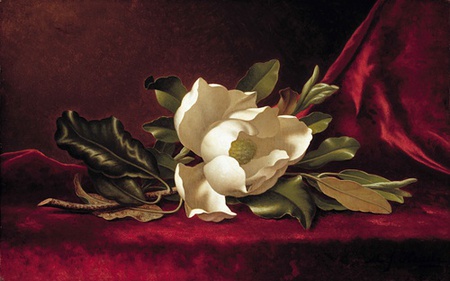Work of the Week #14
Artists, like all of us, are prone to repeating what works. For the nineteenth-century American painter, Martin Johnson Heade, this meant returning time and again to certain successful subjects. For instance, he painted the salt marshes around Newburyport, North of Boston, more than 100 times, starting in the late 1850s. Those works followed a nearly identical formula of long horizontal composition, the bottom third of which was a view of the marsh, crossed by tributaries of the Merrimack River. Dramatic cloud formations dominated the sky above. Later, Heade turned to depictions of colorful hummingbirds in their native habitats. By contrast, these were often short, vertical rectangles in which the painter redeployed the sketches made during three separate trips to Central and South America in the 1860s and 70s. Dozens of works document that particular, long-lived artistic investigation. Heade did execute a few portraits commissions, and lovely seascapes in a style appropriately indebted to his Hudson River School predecessors, but we likely would not remember him nearly so well if he made only those works.
The Timken’s painting by Heade, The Magnolia Blossom, was the first American work to be acquired by the Putnam Foundation, in 1965. The wisdom of that selection is mirrored in this practiced representation of artistic confidence. Magnolia Blossom belongs to the larger series of tabletop floral still life that Heade pursued throughout his career, starting with local apple blossoms before moving on to exotic orchids. Magnolias appear increasingly after he moved to St. Augustine, Florida, in 1883. Like the salt marshes and hummingbirds, numerous excellent treatments of this subject exist-- at least fifteen in all. I can conjure the ones in major museums that rival the Timken version in terms of their simple, direct beauty: Magnolias on a Gold Velvet Cloth, c. 1888-90 (MFA, Houston), Giant Magnolias on a Blue Velvet Cloth, c. 1890 (National Gallery of Art, Washington, DC), Magnolia Grandiflora, 1885-95 (Museum of Fine Arts, Boston), Magnolias on Light Blue Velvet Cloth, 1885/1895 (Art Institute of Chicago) and Magnolia, c. 1885-95 (St. Louis Art Museum). The last of these works most resembles the one in San Diego. The red velvet drape descends from the upper left corner in St. Louis’s work by Heade, not the right. Apart from this, the orientation of the magnolia blossom and the canvas size is virtually the same.
What makes the Timken’s magnolia blossom special, in the end, is the delicate balance between the pearly petals and the surrounding green- and rust-colored leaves, all of which are set against the sumptuous fabric field. The red background resurfaces along the edges of the flower itself. Museum conservators have observed this in other works and declared it a deliberate strategy (see the article by E. L. Fulton, R. Newman, J. Woodward, and J. Wright, “The Methods and Materials of Martin Johnson Heade,” Journal of the American Institute for Conservation, 2002). Heade sought this subtle chromatic vibration so that the ivory-toned blossom would take on a more three-dimensional appearance. A snapshot of a backyard blossom, while satisfying in its own way, can’t compare with the artist’s well-studied, carefully constructed image. Heade worked hard to get it just right.
